
Cover of “Life on the Lower East Side” Photographs by Rebecca Lepkoff, 1937-1950. Text by Peter E. Dans and Suzanne Wasserman. Princeton Architectural Press, New York, 2006.
From November 11, 2012, till January 4, 2013, you can go back in time and see what it was like to live in Manhattan’s Lower East Side during the ’40s—thanks to photographer Rebecca Lepkoff and the Lower East Side Jewish Conservancy.
“On the Cusp of Change: The LES, 1935-1975”—an exhibit of Lepkoff’s photographs—is held at the conservancy’s Visitor Center at 400 Grand Street in Manhattan.
I found out about the exhibit recently when I reached out to Ms. Lepkoff to express my gratitude her for book, Life on the Lower East Side, which I drew heavily on as a research source for Mantis. In it, she brilliantly captured life on the Lower East Side during the middle of the last century—a place where, as her camera reveals, pushcarts full of fruit and vegetables crowded the streets, kids of every background played catch, shoe shine boys and butchers and cobblers plied their trades, laundry hung in wide festoons and seagulls flocked fish market stalls.
I should add that the exhibit was originally scheduled to open a week earlier on the 4th of November, but was postponed due to Hurricane Sandy. Fortunately the Conservancy was able to open the exhibit this week. It’s a piece of good news for a part of the world where so many suffered tragic losses. My thoughts are with them and with all who are still struggling to recover their lives.
I encourage anyone interested in Manhattan’s history or photography to attend the exhibit and view this artist’s beautiful work. Below is a short interview with Lepkoff—produced by Jim Epstein—that features some of her startling duotones.
*The Lower East Side Jewish Conservancy accepts donations which support their ability to preserve and honor the Lower East Side’s history, as they are doing with Lepkoff’s exhibit. (Please check their website for information on how to donate.)
And now a brief excerpt from Mantis inspired by Lepkoff’s work. Here the hero, Lucas, wakes up in the new home he inherited from his father, and heads out into an area of the Lower East Side between the Manhattan Bridge and the Brooklyn Bridge, now buried by a housing development, but fortunately preserved in Lepkoff’s photos as it would have appeared then.
Light. Cold air. Faraway voices. The clatter of a wheel over cobblestones. I open my eyes. I’m in a small sunlit room with an old radio on the floor, a chair, a coffee table, a standing lamp. I have no idea where I am. My legs hang over the arm of a couch. I’ve woken up inside a dream. This is what I think until I see the sketch of a giant man with one ear and realize where I am, that this dream is my new reality.
I look at my watch, my dad’s watch. Six thirty. I don’t know what time Olivia gets to the office, but I want to speak to her as soon as possible. I want to know what she knows and I want to get on the trail of the Beast while it’s still warm.
In my dad’s bedroom I pull out a toiletry case and a shopping bag from Ohrbach’s that I saw in the armoire last night. There are some new clothes in the bag, including a few plain white undershirts, some underwear—Jockey shorts—and socks. Good.
In the bathroom I wash up as best I can at the sink and then with a straight razor I attempt a quick shave. I manage to remove most of my stubble but my face is a bloody mess. Once I’m dressed I fold the contents of my father’s file folder and stuff them inside my jacket, lock up and rush downstairs, out into a street that barely resembles the street from last night. People are everywhere—men in work clothes spill out of the facades, lunch boxes in hand, women wearing kerchiefs lean out of windows talking to each other, and ragamuffin children sit on stoops and fire escape landings. No thin man in a black suit.
The smell of fish is thick in the air as I march down the street, shivering against the morning chill. People look at me, tilt their heads. I’m a stranger in the neighborhood, but somehow vaguely familiar. There’s a pushcart at the curb selling bags of pistachios, Hershey’s Kisses, fruit, bagels, pickles in a barrel. I haven’t eaten since 2012 but I’ve got no appetite. I hurry around the corner past a fenced-in lot, a razed tenement, where a pack of dogs scurries around in rubble and litter. At the end of the lot there’s a stretch of hoarding plastered with movie posters, Clark Gable, Vivien Leigh, Joan Crawford. Just beyond that, I find a set of steps that take me down into a subway station.
